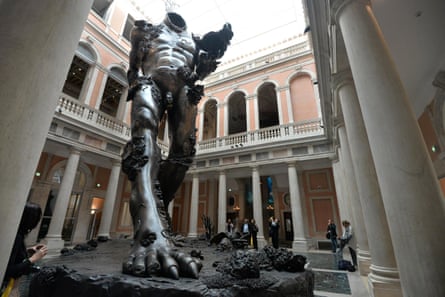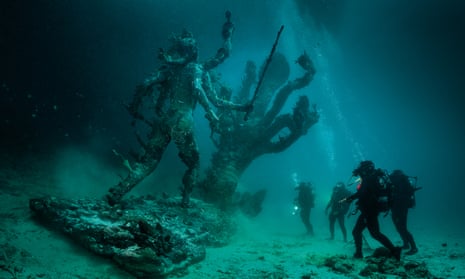In Uusikaupunki, Finland, there is a small museum dedicated to Bonk Business Inc, a “multiglobal industrial conglomerate” specialising in anchovy products, cosmic therapy and localised black holes. The museum chronicles the history and achievements of the company in obsessive detail, displaying old advertisements and inventions dating back to 1893. On the wall hangs a corporate headshot of Sven Triloqvist, vice-president of advanced disinformation systems at Bonk Business Inc.
This colourful corporation is, of course, completely fictitious. It is the work of artist and sculptor Alvar Gullichsen, who uses the format of the industrial museum to poke fun at corporate culture in a way that feels both fantastical and plausibly factual. Straight-faced tour guides encourage you to pose for photos with absurd contraptions.
Meanwhile, Damien Hirst’s 2017 Venice show Treasures from the Wreck of the Unbelievable presented the artist as a wealthy benefactor funding the retrieval and exhibition of awe-inspiring artefacts from the ocean floor. Accompanying the exhibition was a film that documents the underwater archaeology expedition. But none of it was real: the exhibition, documentary and the treasures themselves were all Hirst’s spoof creations.

Fascinating things can be achieved with one foot in history and another in the imaginary. The trappings of historical documentation, or a setting that closely mirrors a place and time in the real world, can lend a flavour of authenticity to art and entertainment. Stéphane Beauverger, the narrative director of Vampyr – a 2018 video game set during London’s Spanish flu pandemic that locates a lurid tale about vampires in recognisable early 20th-century history – calls this concept “imaginary facts”.
Imaginary facts, like works of historical fiction, blend the fictitious with the verifiable: they’re used to tell an artificial yet compelling story. In a landscape where “post-truth” and “alternative facts” are part of our everyday vocabulary, this term might put some on the back foot – but the crucial difference between an imaginary fact and an alternative one is that the audience is fully aware it is a pretence.
To help us temporarily buy in to the proposed reality, artists use the tools and techniques of popular history: documentaries with talking heads, museum exhibitions with white labels and glass cases, hardbacks stuffed with footnoted essays, and interviews and oral histories recorded in crackling analogue. The Bonk Museum is so effective because it borrows from an academic format we’re already familiar with. Schoolchildren around the world are right this moment being bussed off to industrial museums to learn about the achievements of their nation’s economy and manufacturing sector. Industrial museums have universal characteristics: portraits of wealthy industrialists contrasted with shots of anonymous workers on the factory floor, dioramas of workspaces frozen in time, photo opportunities with obsolete machinery.

The second season of podcast series Within the Wires is presented as a series of museum guides. Each episode is ostensibly a guide to a different museum or gallery. Within the Wires uses the techniques usually reserved for non-fiction to tell the jarringly surreal fictional elements of its story. To maintain the illusion, the podcast relies on subtle audio cues, such as repeated beeps that signal the point at which a museum visitor would pause the tape and move on to the next artwork.
“We quickly came up with the idea of museum audio guides because it seemed like a fun challenge, as writers, to try to tell a story so obtusely,” says co-writer Jeffrey Cranor, who also helped create Welcome to Night Vale, a podcast presented as a local radio broadcast about a nonexistent town. “Once you have the form, you can figure out who your narrator is and then you can build a story around that person … What can that museum guide narrator reveal about her life and the lives of these other characters?”
Sometimes these unorthodox formats can be limiting, says Cranor. “The museum season was actually the hardest of the three we’ve written so far, because of the limitations of the form.” But for him and his co-writer Janina Matthewson, they are an experimental challenge. “It gets us out of the normal mode of A-to-B storytelling: how can you give people a good story without ever actually directly telling it?” This indirect mode of storytelling puts more onus on the audience to connect the dots. It turns the show into a puzzle passed back and forth between creator and listener.

The TV series Fargo, meanwhile, borrows from a different format to create the illusion of fact: true-crime drama. One of the only consistent features between seasons is the disclaimer that opens each episode: “This is a true story … At the request of the survivors, the names have been changed. Out of respect for the dead, the rest has been told exactly as it occurred.” The words of the disclaimer work like a repeated incantation before each episode, casting a spell that suspends our disbelief each week. The video game Mafia III also adopts the aesthetics of true crime, with expert talking heads whose insights bookend the events of the game.
The thrill of imaginary facts rests on the audience being in on the deception – those taking photographs at the Bonk Museum and absorbing the month’s spooky events in Welcome to Night Vale are willing and eager dupes. As Cranor puts it, there’s something thrilling about “the humour and the horror of something that looks like and sounds predictable, but then deep down it’s just not quite right. It’s not quite real.”

Comments (…)
Sign in or create your Guardian account to join the discussion